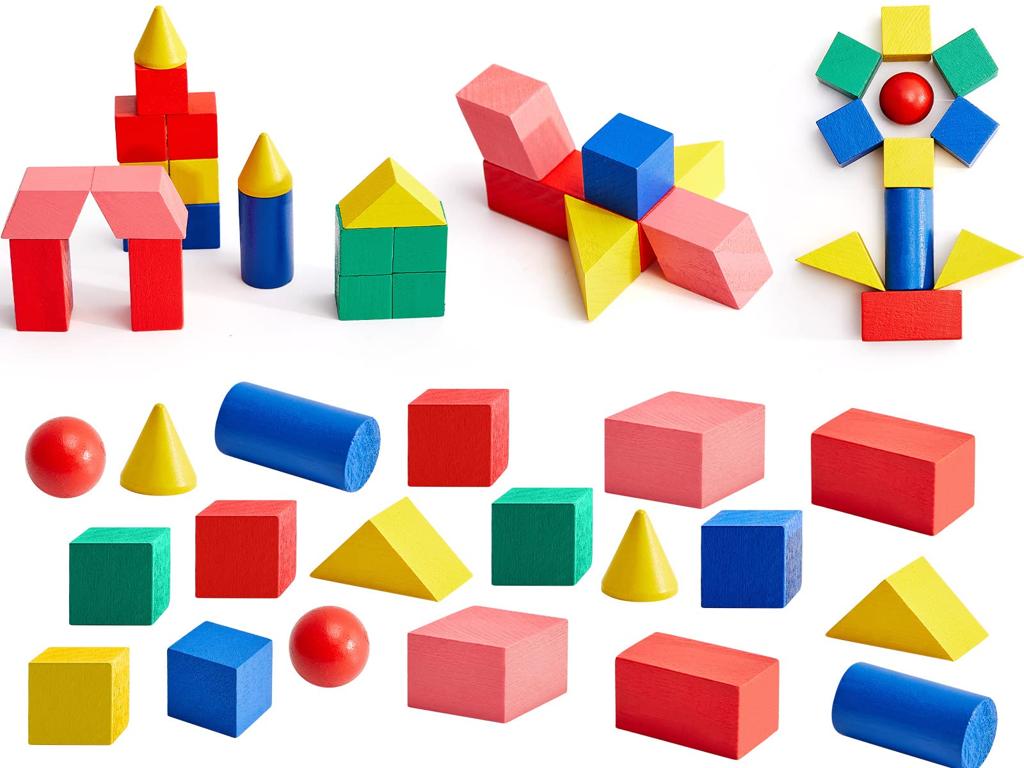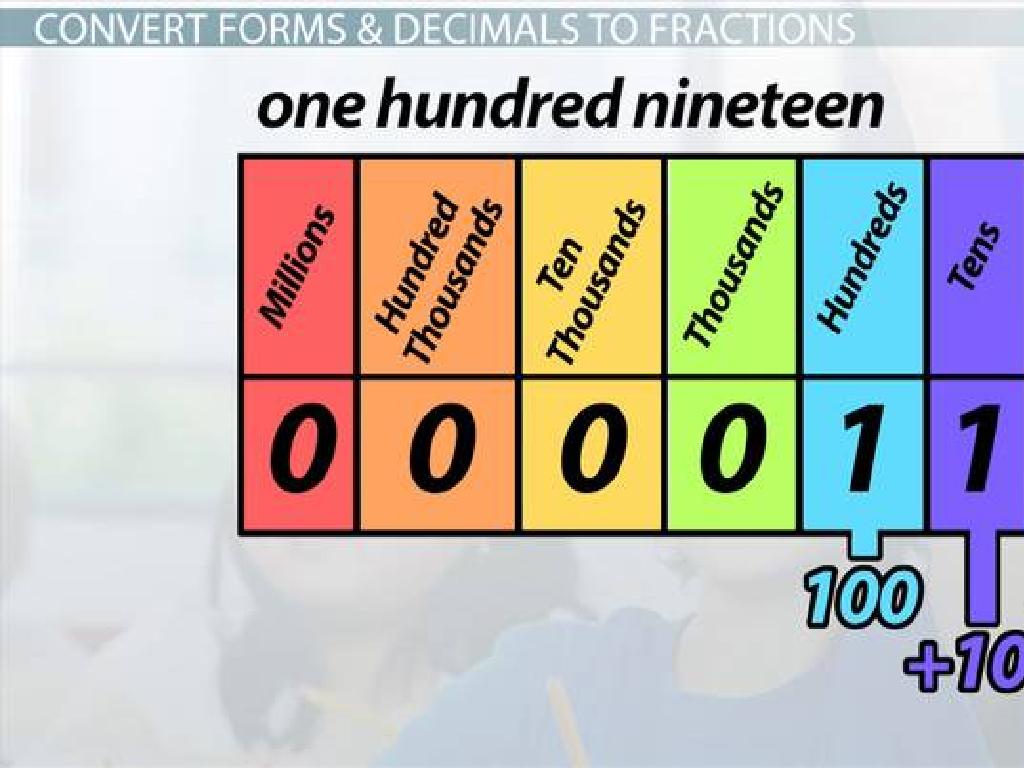Complete The Equation Using Properties Of Addition
Subject: Math
Grade: Third grade
Topic: Addition Properties
Please LOG IN to download the presentation. Access is available to registered users only.
View More Content
Welcome to Addition Properties!
– Greetings, young mathematicians!
– Today’s focus: Addition Properties
– Commutative, Associative, and Identity properties
– Why learn about Addition Properties?
– Helps in solving math problems efficiently
– How Addition Properties help us
– Makes math easier and prepares for advanced concepts
|
Begin the class with a warm welcome, setting a positive tone for learning. Introduce the concept of Addition Properties, which includes the Commutative Property (changing the order of addends doesn’t change the sum), the Associative Property (changing the grouping of addends doesn’t change the sum), and the Identity Property (adding zero to any number gives the number itself). Explain that understanding these properties is crucial as it helps students solve addition problems more efficiently and lays the groundwork for more complex mathematical concepts. Use examples to illustrate each property and encourage students to think of their own examples. This introduction will prepare them for activities and further learning about Addition Properties.
Review: Understanding Addition
– Recall the concept of addition
– Addition is putting together amounts
– Addition combines numbers
– When we add, we put together two or more numbers to make a new total
– Example with apples
– If you start with 2 apples and get 3 more, you combine the amounts
– How many apples in total?
– Think: 2 apples + 3 apples = ? apples
|
This slide is a review of the basic concept of addition, aimed at helping third-grade students recall and understand how addition works. Start by asking students what they remember about addition. Explain that addition is the process of combining two or more numbers to find a total amount. Use a relatable example, such as combining apples, to illustrate this concept in a tangible way. Ask the students to visualize having two apples in one hand and getting three more apples to add to their collection. Then, prompt them to calculate the total number of apples to reinforce the concept. This example will help students connect the abstract concept of addition to a concrete experience, making it easier for them to grasp and apply the properties of addition in subsequent lessons.
Commutative Property of Addition
– Add numbers in any order
– Whether you add 5 to 4, or 4 to 5, the sum is 9
– Example: 4 + 5 equals 5 + 4
– It shows addition is flexible
– Activity: Practice together
– We’ll add different numbers and see it’s always true
|
This slide introduces the Commutative Property of Addition, which states that numbers can be added in any order and the sum will be the same. Start by explaining the property with simple examples, such as 4 + 5 and 5 + 4. Emphasize that the order of numbers does not affect the sum. For the activity, have students come up with their own number pairs to add in different orders. Possible activities could include using manipulatives like counters or number cards, solving problems on a whiteboard, or creating a worksheet with addition problems to solve in class. The goal is for students to understand and demonstrate that the sum remains constant regardless of the order in which two numbers are added.
Associative Property of Addition
– Grouping doesn’t change sum
– Whether we group 6 with 7 or 7 with 2, the total sum is the same.
– Example: (6 + 7) + 2 = 6 + (7 + 2)
– Both ways give us the same answer: 15
– Activity: Regroup and add
– Try regrouping these numbers: (3 + 4) + 5 and 3 + (4 + 5)
|
This slide introduces the associative property of addition, which states that the way in which numbers are grouped does not affect the sum. Use the example provided to show that no matter how the numbers are grouped within the parentheses, the sum remains the same. For the activity, encourage students to work with different groupings of numbers to find the sum, reinforcing the concept that the sum is invariant under different groupings. Provide guidance on how to perform the activity, and prepare additional examples for students who finish early or need extra practice.
Identity Property of Addition
– Zero added to any number
– The number stays the same
– Example: 8 + 0 = 8
– Adding 0 to 8, we still get 8
– Explore adding zero to numbers
– What if we add 0 to 5, 10, or 15?
|
This slide introduces the Identity Property of Addition, which states that adding zero to any number will not change the number’s value. It’s crucial for students to understand that zero is the ‘do nothing’ number in addition. Use the example provided (8 + 0 = 8) to show that the sum is the same as the original number. Then, encourage students to apply this property by adding zero to different numbers as a class activity. Ask questions like ‘What is 5 plus 0?’ or ‘What is 10 plus 0?’ to reinforce the concept. This will help them grasp that the identity property is true for all numbers.
Completing Equations with Addition Properties
– Using properties to find missing numbers
– Understand how addition properties help solve equations.
– Example: 3 + __ = __ + 3
– The missing number is the same on both sides due to the Commutative Property.
– Let’s practice completing equations!
– We’ll work through examples as a class to master this skill.
|
This slide introduces the concept of using addition properties to complete equations. Start by explaining that properties of addition, like the Commutative Property, tell us that numbers can be added in any order and the sum will be the same. Use the example provided to illustrate this point. The answer to the example is that the blank spaces must both be the same number to maintain balance in the equation. During class practice, provide students with similar equations and guide them through the process of identifying the missing numbers using addition properties. Encourage participation and assist students who may need extra help. This activity will reinforce their understanding of addition properties and how they apply to solving equations.
Class Activity: Equation Builders
– Pair up and use number cards
– Create equations with addition properties
– Commutative, Associative, or Identity properties of addition
– Explain the used property
– Share equations with the class
|
This interactive class activity is designed to help students understand and apply the properties of addition through hands-on experience. Provide each pair of students with a set of number cards. Students will use these cards to create equations that demonstrate the commutative, associative, or identity properties of addition. After creating their equations, each pair will explain to the class which property they used and how it applies to their equation. This will reinforce their understanding and allow them to see a variety of examples from their peers. Possible activities: 1) Commutative property card swap, 2) Associative property group challenge, 3) Identity property match-up, 4) Mixed property challenge, 5) Equation creation contest.
Conclusion: Properties of Addition
– Recap: 3 addition properties
– Commutative, Associative, Identity properties
– Importance of addition properties
– They help us solve addition problems easily
– Get ready for more practice
|
As we wrap up today’s lesson, let’s review the three properties of addition we’ve learned: the Commutative Property, which tells us that numbers can be added in any order; the Associative Property, which shows us that no matter how we group numbers, the sum remains the same; and the Identity Property, which reveals that adding zero to any number gives us the same number. Understanding these properties is crucial because they simplify complex addition problems and build a foundation for algebraic thinking. For the next class, students should be prepared to engage in more exercises to reinforce their grasp of these properties, ensuring they can apply them with confidence in various mathematical scenarios.






